Best price to quality ratio - delivered
Liquid Filtration System
Liquid Filtration System
LOSMA S.P.A, ITALY In INDIA for salse and service support of
a) Liquid filtration, band or self cleaning filtration systems for coolant to remove pollutant particles
c) Dust and Fume Extractor
Losma is a group started in 1974 to offer industries and manufacturing companies the opportunity to "work clean and breathe healthy". In industrial production, the treatment of air and of liquid lubricants and coolants is the most essential requirment to work clean and breathe healthily. Tech Mach Machine Tools Bangalore are pleased to introduce these machines to the India market as supplier agency. Tech Mach Machine Tools Bangalore are dealers and suppliers of reputed Liquid Filters.
DTE-LIQUID FILTRATION
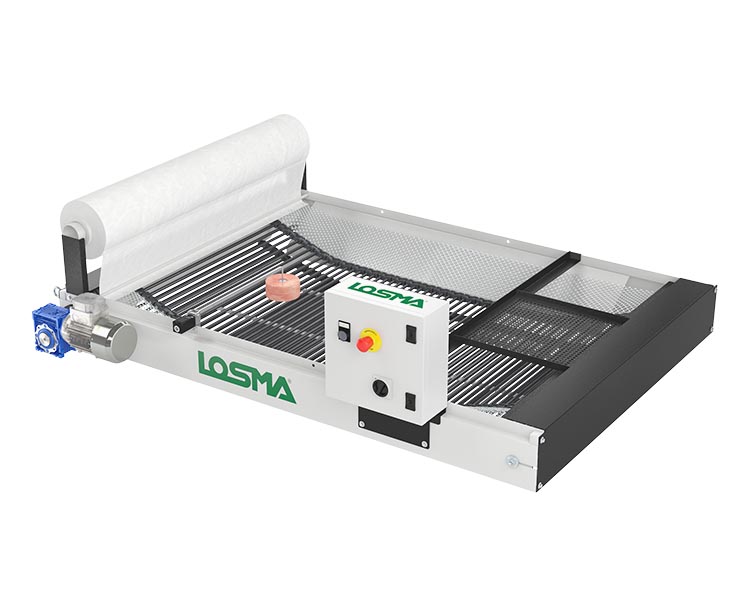
Detex is a flat bed coolant filter, using non-woven tissue for eliminating magnetic and non- magnetic particles from neat oil and emulsion. Filtration degree can be determined by the choice of the tissue, ranging from 10 to 50 micron, granting the highest level of filtration. Detex is available in 7 models, with a flowrate capacity from 50 to 400 l/min of emulsion and from 25 to 200 l/min of neat oil
Working Principles
The dirty coolant falls into the distribution trough and from here onto the filter tissue which retains solid pollutant particles (dust and swarfs) while the filtered oil passes through it.
The tissue collects progressively the pollutant, until loosing its filtering capacity. At this stage the liquid collects on the through and lifts the float and starts an automatic system, which advances the collection tray to change the exhausted fabric with the new one.
Exhausted fabric is collected in a dedicated tank. The clean liquid is collected the tank below, in order to be pumped back to the machine tool.

SKIM-LIQUID FILTRATION
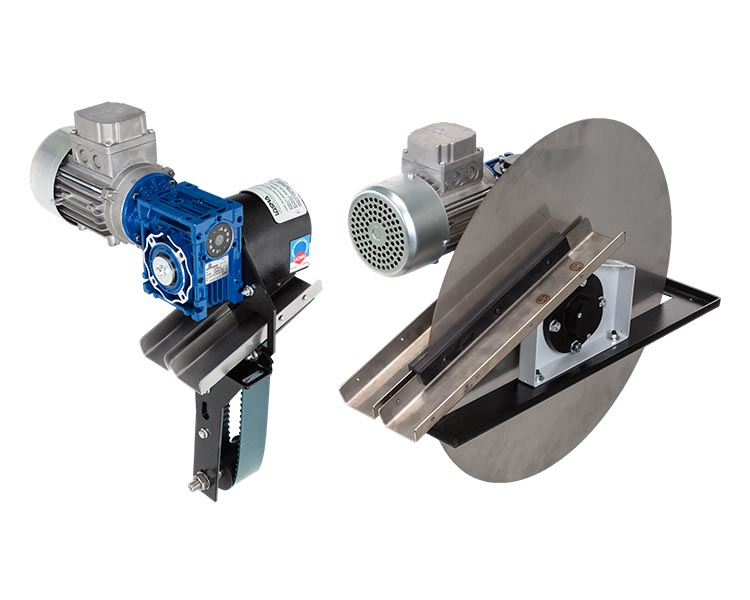
SKIM is an eliminator of superficial oil, suitable to be used on every kind of tank, thanks to its shape and design. Skim is available in two versions: disc (Skim D) or belt (Skim N). This last version is suitable, thanks to its installation dimensions, in situations of reduced space and when the tank is not at full capacity. Skim preserves the quality of coolants and eliminates unpleasant odours caused by anaerobic flora bacteria, which would otherwise be generated.
As it is already well known, the emulsions used in mechanical machining process and liquids used in washing machines, it allows an accumulation of
light products which do not mix with water on the surface. This veil, which can reach considerable sizes, from 0,1 to 2 mm, creates a barrier and
prevents air from entering into contact with the emulsion. This allows the formation of anaerobic flora bacteria, which are the main causes of the
decay and the putrefaction of emulsions. It is therefore imperative to remove from the liquid surface that veil of oil and those superficial
polluting agents that induce the decay. Due to its great supply of accessories Skim can be mounted either on the tank edge, on the cover, encased or
on an internal structure. The extreme simple construction limits the maintenance. The wearing control of scrapers and the
periodical cleaning of waste discharging off allows the system in perfect working conditions.
Working Principles
The disc/belt is immersed into the liquid. Thanks to rotation the polluting agents stick to its surface and are dragged out.
During rotation the disc/belt meets two scrapers fitted with a rubber rim which remove the film of polluting agents stuck to it and transport it outside by means of exit ducts.
Skim can be equipped with an electrical control board with the possibility of setting up a temporized working cycle.

MAGNETO-LIQUID FILTRATION
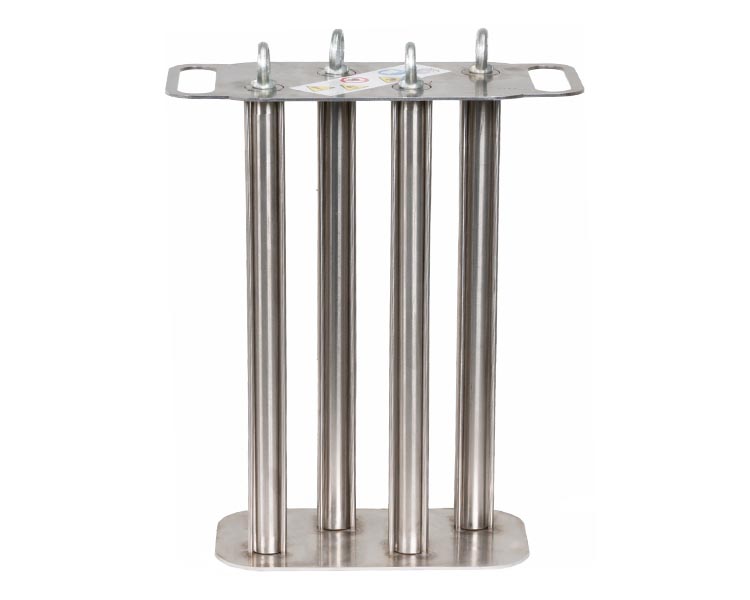
MAGNETO is an ultrafine magnetic separation system, which can be adapted and personalised thanks to its ease of use. It is realised totally in stainless steel Aisi 304 and is provided with permanent magnetic elements in neodymium with a power of 5000 Gauss.
Working Principles
MAGNETO separator has to be inserted in the clean coolant tank, in an area near to the pump, so that the liquid can pass through its magnetic bars.
The maximum performance is obtained by channeling the coolant in a longitudinal way, with simple bulkheads.
The cleaning for the Magneto separator is very quick and easy: Magneto is removed from the liquid, slipping the bars out of their position and discharging the waste into a container.

SPRING-LIQUID FILTRATION
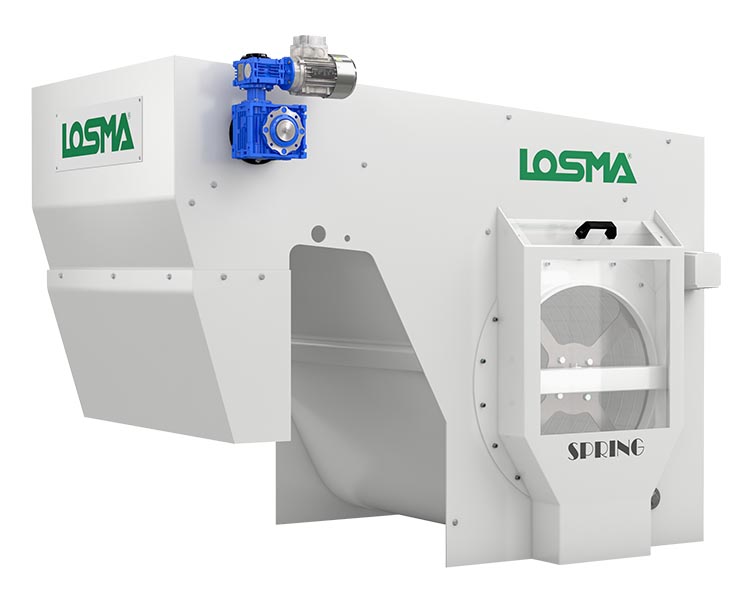
Spring is a self-cleaning drum filtration system, with permanent metallic net, suitable to clean neat oil or emulsion from magnetic or non-magnetic particles. It’s available in 9 sizes with flowrates from 25 to 1000 l/min of neat oil and from 50 to 2000 l/min of emulsion. Drum’s filtration efficiency can be customized following the needs of the customer.
Working Principles
The filter fabric covering the drum is clean. The dirty coolant passes through it depositing the pollutant particles and goes through the discharge opening.From here the cleancoolant falls into the collection tank positioned below, from where pumps will transfer it back to the machine tool. During this phase the drum does not rotate and the dredging system is stationary. The polluting particles deposited on the filter net forms the actual filtering layer which can also reach a thickness of 10-15 mm.
As the filter net gradually gets dirty, the liquid level increases. The dirty coolant continues to deposit pollutant particles onto the drum surface, while the drum and dredging system are still. The filtration level improves due to the thickness of the mud deposited on the filter net.
Coolant cannot pass through the filter net any longer – filter net clogging cycle is complete. This phase is when the best filtration level is reached. The longer the filter operates under these conditions, the better the average filtration will be. When the coolant reaches the maximum internal level allowed, a self-cleaning cycle is started automatically (see box page 4). At the end of this phase the coolant level descends and the filtration cycle begins again.

SPRING COMPACT-LIQUID FILTRATION
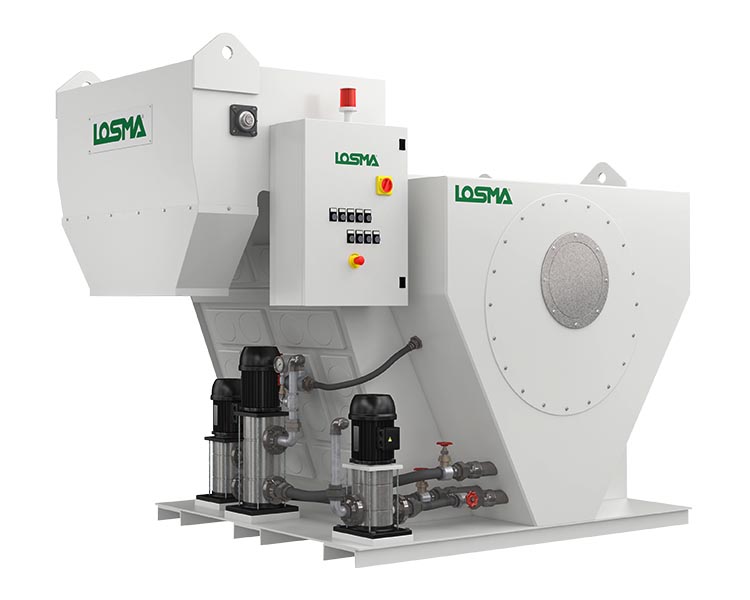
DMD and DMD P are rotating magnetic discs separators for coolants used during industrial machining contaminated by magnetic particles. DMD series is available in 7 standard models for flowrates ranging from 50 to 400 l/min of emulsion and from 25 to 200 l/min of neat oil. DMD P is designed for high flowrates, available in 5 models, able to filter from 600 to 1800 l/min of emulsion and from 300 to 900 l/min of neat oil. The robust structure of DMD-P is suitable for big machine tools, centralized applications, machining centers, grinding, deep drilling and hard machining.
Working Principles
The filter fabric covering the drum is clean. The dirty coolant passes through it depositing the pollutant particles and goes through the discharge opening. From here the cleancoolant falls into the collection tank welded in one piece with the filter, from where pumps will transfer it back to the machine tool. During this phase the drum does not rotate and the dredging system is stationary. The polluting particles deposited on the filter net forms the actual filtering layer which can also reach a thickness of 10-15 mm.
As the filter net gradually gets dirty, the liquid level increases. The dirty coolant continues to deposit pollutant particles onto the drum surface, while the drum and dredging system are still. The filtration level improves due to the thickness of the mud deposited on the filter net.
Coolant cannot pass through the filter net any longer – filter net clogging cycle is complete. This phase is when the best filtration level is reached. The longer the filter operates under these conditions, the better the average filtration will be. When the coolant reaches the maximum internal level allowed, a self-cleaning cycle is started automatically (see box page 8) and the drum rotates. At the end of this phase the coolant level descends and the filtration cycle begins again.

DMD SERIES-LIQUID FILTRATION
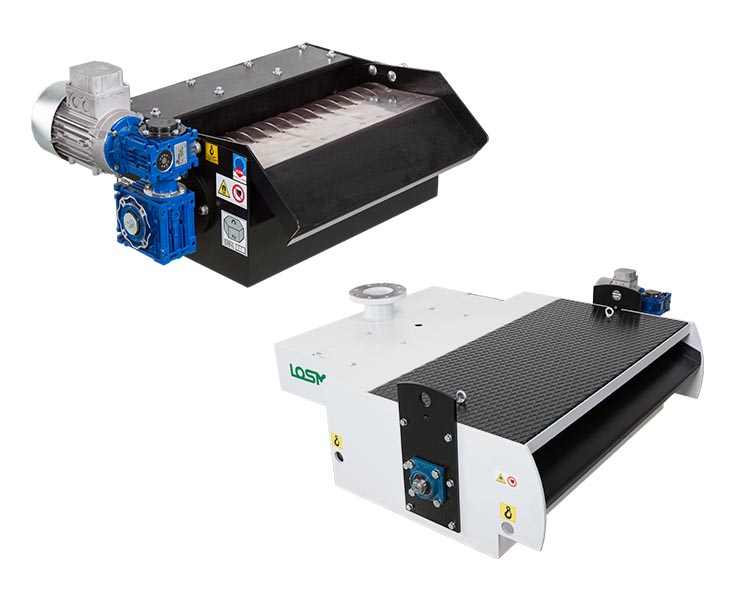
DMD and DMD P are rotating magnetic discs separators for coolants used during industrial machining contaminated by magnetic particles. DMD series is available in 7 standard models for flowrates ranging from 50 to 400 l/min of emulsion and from 25 to 200 l/min of neat oil. DMD P is designed for high flowrates, available in 5 models, able to filter from 600 to 1800 l/min of emulsion and from 300 to 900 l/min of neat oil. The robust structure of DMD-P is suitable for big machine tools, centralized applications, machining centers, grinding, deep drilling and hard machining.
Working Principles
Contaminated coolant passes through the group of rotating magnetic discs, where magnetic particles are captured.
A scraping blade removes the metallic particles from the rotating group, conveying them to the sludge chute which collects the waste into a tank.
Clean oil is collected into a tank and pumped back to the machine tool thanks to a dedicated pump, or is collected for a further process of fine filtration.

MASTER SERIES-LIQUID FILTRATION
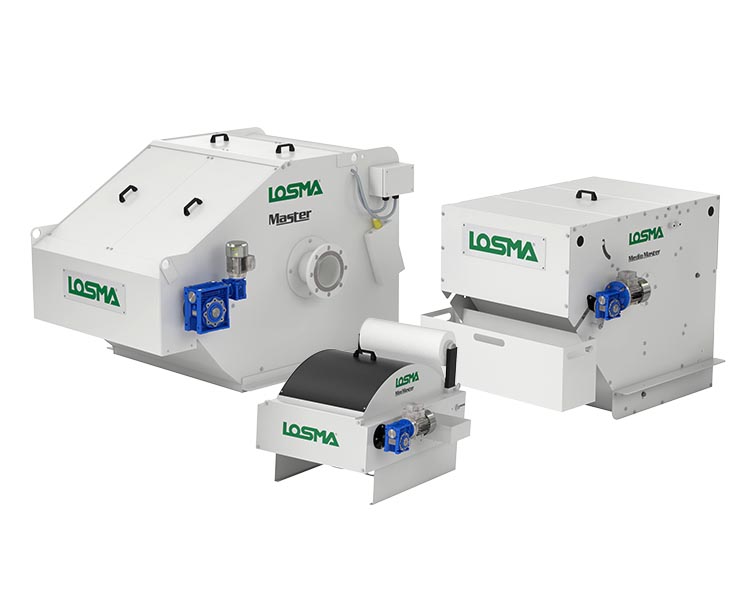
MASTER is a range of high efficiency gravity filters, using non-woven fabric as filter media. Master series is available in 4 models, able to manage flowrates from 200 to 1000 l/min of neat oil and from 400 to 2000 l/min of water based emulsion, contaminated by metallic or non-metallic particles. Master’s operation is simple and its efficiency is stable and constant. This type of filter is suitable for cooling and lubricant liquids used in many industrial processes, such as: drawing, milling, polishing, grinding and washing amongst others.
Working Principles
The filtering tissue, stretched inside the filter, is perfectly clean. The dirty liquid enters in the system and has to pass through it to go to the lower tank, thus depositing pollutant particles on its surface. The clean liquid goes through the lower part where the discharge opening is located and falls into the tank underneath. During this phase the system is idle and the carpet is not advancing; pollutant which is deposited on the filter fabric forms the actual filtering layer, which in many applications can reach a thickness of 10 mm.
The dirty filter tissue permeability is reduced, because the dirty liquid continues to deposit the pollutant onto its surface, and the coolant level starts increasing. The filtration degree improves due to the thickness of the mud deposited on the filter tissue. During this phase the system is idle.
The liquid has reached its maximum level, at this stage the best possible filtration degree is actually reached. The longer the filter operates in this condition, the better the average filtration will be. The system is idle also in this phase.
When the tissue is totally obstructed and the liquid cannot pass through it anymore, the regeneration cycle begins. Motor reducer allow the system to rotate and moves the dirty filter tissue, while the clean one is introduced and permeability restored, allowing for the level to descend and return to intermediate condition 2.

EXTRA-LIQUID FILTRATION
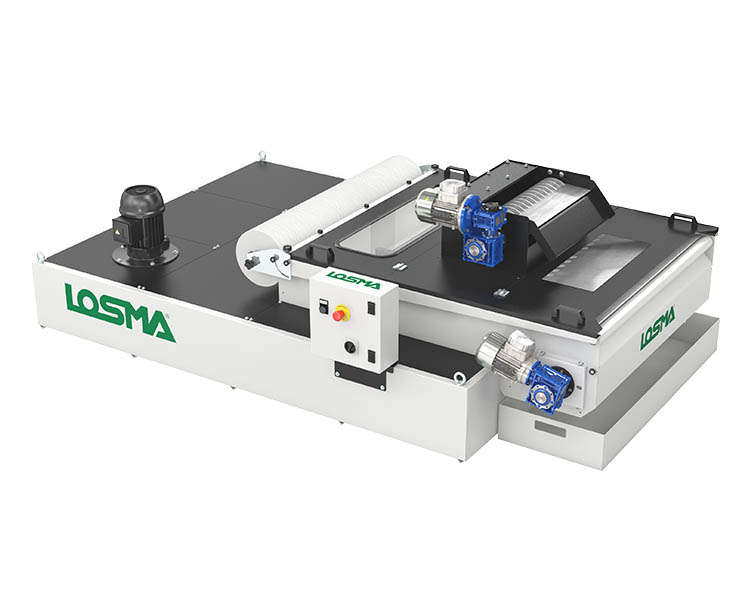
Extra and Extra High are two new gravity bed filters for coolants, which uses non-woven filtration tissue for eliminating magnetic and non-magnetic particles from neat oils and emulsions. Filtration degree is set thanks to the tissue choice and varies from 10 to 50 microns, securing a very high depuration level. Extra is available in two versions, normal or High with double bed, and 11 models for throughput from 50 to 300 l/min for neat oils and from 100 to 600 l/min for emulsion.
Working Principles
Contaminated coolant is piped into the trough and distributed on the filtration tissue, retaining pollutant particles and allowing the cleaned coolant to pass.
The tissue collects pollutant particles until it is full and the coolant cannot cross it anymore. The coolant rises its level touching a float, which actions the proximity sensor controlling the tissue movement and the replacing with the new one.
Dirty tissue is collected in a dedicated tank, while sludge are separated from a scraping blade, or it can be also rewound with a dedicated system (optional).
The clean liquid pass in the tank below and is sent back to the machine tools thanks to the dedicated electrical pump.


#634, 3rd cross, HMT layout,
Ganganagar, R T Nagar, Bangalore-560032.
Karnataka State, INDIA.

+91 98450 68437
skr@techmach.in
sales@techmach.in